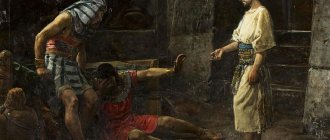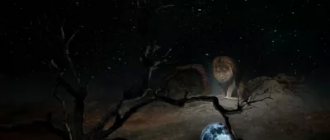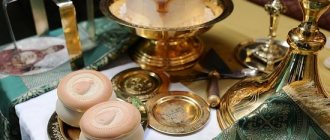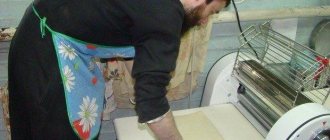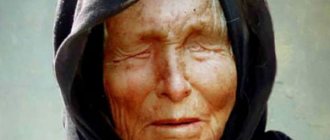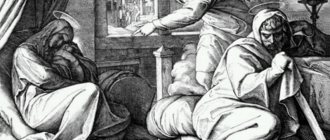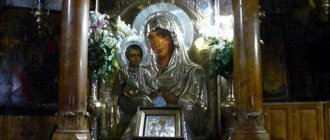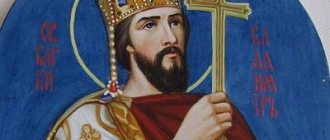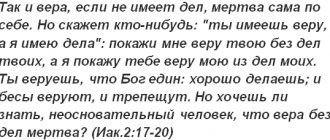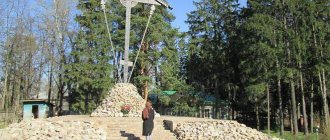№3 (372) / January 15 '06
Basics of Orthodoxy
In this topic:
Basics of Orthodoxy
Rules of conduct in the temple
Basics of Orthodoxy
From the statutory rules of worship (On the signs of the cross and bows)
In the Sacrament of the Eucharist, bread and wine are transformed into the true Body and Blood of Christ
At the Divine Table we should not simply see the bread and cup offered, but, elevating our minds, we should understand by faith that at the Holy Table lies “the Lamb of God, who takes away the sin of the world” (John 1:29), sacrificed by the priests .
And truly accepting His honorable Body and Blood, we must believe that these are signs of our Resurrection.
(I Ecumenical Council)
Proclaiming the death according to the flesh of the Only Begotten Son of God, that is, Jesus Christ, and confessing His Resurrection and Ascension into heaven, we perform the Bloodless Sacrifice in the churches. And thus we approach the Blessed Mysteries and become sanctified, partaking of the Holy Body and the honest Blood of the Savior of us all, Christ, and accepting not ordinary flesh and not as the flesh of a person sanctified and united with the Word in unity of dignity, but as truly the Life-Giving and Own Body of Himself Words. For He (Jesus Christ), as God, being Life by nature, when He became one with His own Flesh, made it Life-giving. And therefore, although He tells us: “Truly, truly, I say to you, unless you eat the Flesh of the Son of Man and drink His Blood” (John 6:53), we must not regard it as the flesh of a man who is like us in everything ( how could human flesh by its nature be life-giving?), but truly for the own Flesh of Him who for our sake was made and called the Son of Man.
(III Ecumenical Council)
None of the messengers of the Spirit, that is, the holy apostles and our illustrious fathers, called the Bloodless Sacrifice, performed in remembrance of the suffering of our God and His entire Economy, the “image” of His Body, for this is not how they heard from the Lord. They heard Him preaching: “Unless you eat the Flesh of the Son of Man and drink His Blood, you will not have life in you (John 6:53)… He who eats My Flesh and drinks My Blood abides in Me, and I in him.” (John 6, 53; 56); and again: “Take, eat: this is My Body” (Matthew 26:26), but He did not say: “Take, eat the image of My Body.” So, it is clear that neither the Lord, nor the apostles, nor the fathers ever called the Bloodless Sacrifice offered by the priests an “image,” but the Body itself and the Blood itself. And although before consecration takes place, it seemed pious to some of the holy fathers to call bread and wine “substitutes,” but after consecration they become the Body and Blood of Christ, and so we believe. Acts
VII Ecumenical Council
We accept the Eucharist not as simple bread and not as simple drink, but just as Jesus Christ our Savior, having become incarnate as the Word of God, had Flesh and Blood for our salvation, in the same way this Food, over which thanksgiving is said through the prayer of His Word, according to Transfiguration, which nourishes our blood and flesh, is the Flesh and Blood of the same incarnate Jesus Christ.
Hieromartyr Justin the Philosopher
Just as earthly bread, through the invocation of God on it, is no longer ordinary bread, but the Eucharist, consisting of earthly and heavenly, so our bodies, partaking of the Eucharist, are no longer corruptible, but have the hope of the Resurrection.
Saint Irenaeus of Lyons
The Bread and Wine of the Eucharist, before the holy invocation of the adored Trinity, was simple bread and wine. After the invocation is completed, the bread becomes the Body of Christ, and the wine becomes His Blood.
Saint Cyril of Jerusalem
In the Holy Mysteries Christ is fully present
We believe that in each part, down to the smallest particle of bread and wine, there is not any separate part of the Body and Blood of the Lord, but the Body of Christ, always whole and in all parts one, and the Lord Christ is present in His Essence, that is, with Soul and Deity, as a perfect God and a perfect man. Therefore, although at the same time there are many sacred rites in the universe, there are not many bodies of Christ, but one and the same Christ is truly and truly present, one His Body and one Blood in all the individual churches of the faithful. And this is not because the Body of the Lord, which is in Heaven, descends on the altars, but because the bread of transfiguration, prepared separately in all churches and, after consecration, translated and transposed, becomes one and the same with the Body that is in Heaven. For the Lord always has one Body, and not many in many places. That is why this Sacrament, according to the general opinion, is the most wonderful, comprehended by faith alone, and not by the speculations of human wisdom, the vanity and madness of whose research about the Divine is rejected by this Holy and above-determined Sacrifice for us.
Message of the Eastern Patriarchs
The Lamb of God is fragmented and divided, fragmented and undivided, always eaten and never consumed, but sanctifying those who partake.
From the Missal
“What is impossible with men is possible with God” (Luke 18:27)
When Christ Himself said about bread: “This is My Body” (Matthew 26:26), after that who will dare not to believe? And when He Himself assured and said about the cup: “This is My Blood” (Matthew 26:28), who then will doubt and say that this is not His Blood? In Cana of Galilee, he once transformed water into wine (John 2:1-10), similar to blood, and is he not worthy of faith when he turns wine into Blood? If, called to the wedding, He performed this glorious miracle, isn’t it all the more so when He gave His Body and Blood to the sons of the bridal chamber (Matthew 9:15) for salvation? Does he require our faith? Therefore, with full confidence, let us accept this as the Body and Blood of Christ. For in the form of bread the Body is given to you, and in the form of wine the Blood is given to you, so that by partaking of the Body and Blood of Christ, you may become co-corporeal and of the same blood with Him. This is how we become Christ-bearers when His Body and Blood are united with our body and blood. Thus, according to Blessed Peter, we become “partakers of the Divine nature” (2 Pet. 1:4)... So, do not consider the bread and wine (in the Eucharist) simple, for they are the Body and Blood of Christ, according to the saying of the Master.
Saint Cyril of Jerusalem
If anyone expresses doubt and unbelief in the Divine Sacrament - how the bread at the Table is transformed into the Body, and the wine - into the Blood of Jesus Christ, the Son of God, and becomes His true Body and Blood in sacred service - then every Orthodox Christian must ask it is like this: “Can God make greater than man and above his understanding?” And when he says: “He can,” tell him: “Why can’t He give us His Flesh for food?” “By the word of the Lord the heavens were created” (Ps. 32:6), with the same word of God He transforms bread and wine into His Body and Blood.
And if you are surprised at how the same Christ is both at the Table and in Heaven, then be amazed at how the same sun, which illuminates and warms us here, at the same time shines in the sky, and on earth, and in the east , both in the West and in all countries of the world. So Christ is - at the same time both in Heaven and on earth - in the Most Pure Mysteries, as one Almighty and All-Powerful; both in Heaven, truly by nature, and on earth, by the power of the Divine, he performs great and glorious deeds, incomprehensible and indescribable, above the human mind.
And again, if you are surprised at how one Christ is presented equally whole to the faithful in many parts, no less in one part and no greater in another, be amazed at how my one voice is in my mouth and in your ears. the same voice?
And if you are surprised how the Body is not crushed in the fragmentation of the Mysteries, when the Lamb is fragmented, and how in every part there is a whole and perfect Christ, marvel also at how it happens when a mirror is broken, the reflection in every part remains whole, as in the complete mirror?
If you are amazed at how Christ, often devoured, is not diminished, but remains whole forever, be amazed at how, when you light other candles from one candle, you do not thereby diminish the brightness of the first candle?
And if you ask how Christ, having entered into our nature, is not defiled and not limited, then I will ask: the sun, passing over unclean places, is desecrated by this or not? I know that the wise and faithful will not dare to say: yes! Moreover, Christ, the Light of all purity, is not defiled, and He who is, Whom neither hell, nor the seals of the tomb, nor the doors at the entrance to the disciples, closed and locked, could be held back.
And if you are surprised how a small particle of the Mysteries contains the whole of Christ, then be amazed at how such great cities are contained and embraced in such a small pupil of yours? But, having learned this, do not strive to know the unknowable Mystery, but with undoubted faith and heartfelt love give thanks to the Terrible and Strong and Almighty King and God Almighty in deeds and mind - for His inscrutable gifts.
And in discussing the Body of the Lord, believe with the Church about the Terrible Mysteries. Although you see bread and wine with your eyes, firmly, without a doubt, believe that their essence, by the influx and action of the Holy Spirit and the power of the Almighty Word of God, is transformed into the Body and Blood of Christ, so that nothing else remains here, but only the truest The Body and Blood of the Lord in the form of wheat, leavened, freshly baked soft bread and wine pressed from grapes.
Saint Demetrius of Rostov
When the Lord proposed the doctrine of the Sacrament of the Body and Blood, believing in it a necessary condition for communication with Himself and the source of true life, “many of His disciples departed from Him and no longer walked with Him” (John 6:66). Such a work of God’s boundless mercy towards us seemed too wonderful to them, and their dislike for the miraculous alienated them from the Lord. The Lord saw this, and, however, ready to be crucified for the salvation of everyone, did not find it possible to diminish or cancel the miraculous. So it is necessary in the economy of our salvation! Although, of course, with regret, He left them to go from Himself into the darkness of unbelief and destruction, and not only to them, but also to the chosen twelve He said on this occasion: “Would you also like to depart” (John 6:67), expressing readiness to let them go if they do not bow to the miraculous. It follows from this that avoiding the miraculous is the same as avoiding the Lord the Savior, and one who turns away from the miraculous is the same as perishing. Let those who are horrified at the mere reminder of the miraculous heed this! They will also encounter a miracle that they will no longer be able to contradict: this is death and after death judgment. But whether this non-interference will serve them as salvation, only God knows.
Bishop Theophan the Recluse
Arriving in Seleucia, near Antioch, we met with the bishop of the city, Abba Theodore. He told us about the following event that happened under his predecessor at the episcopal see - Blessed Dionysius. There lived a rich merchant, a very God-fearing man. He adhered to the heresy of the North, but he had a servant who belonged to the Holy Catholic and Apostolic Church. According to the custom of the country, on Holy Thursday he accepted the Holy Gifts, wrapped them in clean linen and put them in his closet. After Easter, the merchant needed to send a servant to Constantinople on trade matters. He set off, but, forgetting about the Holy Gifts, left them in his closet and handed the key to the owner. One day, the owner, opening the closet, found a canvas with the Holy Gifts located there. Confused, he did not know what to do. He did not dare to accept them, not belonging to the Catholic Church. So this time he left them in the closet, reasoning that his servant would receive them when he returned. But the day of Maundy Thursday passed again, and the servant had not yet returned. Then the owner decided to burn the Holy Gifts so that they would not remain for another year. Opening the closet, he saw that all the Holy Particles had sprouted into stalks and ears of corn... Fear and trembling overwhelmed him at the sight of a new and extraordinary miracle. Taking the Holy Gifts, he, loudly repeating: “Lord, have mercy!”, hurried with the whole house to the holy temple to Bishop Dionysius. This great and terrible miracle, surpassing all intelligence and understanding, was seen not by two or three, or a few, but by the entire congregation. Everyone thanked God for the indescribable and incomprehensible sign. Many, having believed after the miracle, joined the holy Apostolic Church.
“Spiritual meadow” Internet page “Path to the temple” https://tropinka.orthodoxy.ru
In other rooms:
How does the Gospel explain?
Photo: Foma.ru
But why was the wine called the blood of Christ, and the bread his body? The Holy Gospel itself tells us about this through the mouth of Christ:
Moses did not give you bread from heaven, but My Father gives you the true bread from heaven; for the bread of God is the one who comes down from heaven and gives life to the world... I am the bread of life... I am the living bread that came down from heaven; whoever eats this bread will live forever (John 6:32, 33, 35, 48, 51).
Grapes are a symbol of the people whom the Lord chose. “The vineyard of the Lord is Israel, and the people in it are the beloved plants in that vineyard” (Book of the Prophet Isaiah).
And the New Testament says more specifically that after Jesus Christ began to live among people, he is the True Vine, God the Father is the vinedresser, and all people who believe in Christ are branches of this true Vine (Gospel according to John) . That is, it is a symbol of the entire Church, united by one root. The fruit of the vine is true Faith. And when wine is made from the fruit and poured into a cup - this is the main result of all labors - both Divine and human.
Thus, bread and wine taken together is the unity of the true God and people who have true faith in Him.
Lanchang Miracle
Photo: Dic.academic.ru
To explain the mystery of flesh and blood, it is necessary to talk about the great miracle that happened in San Legontius - a small church in the Italian city of Lanciano - in the 8th century AD.
One of the priests celebrated the Eucharist, but at the same time doubts swarmed in his head - whether what he was doing was true. Why do wine and bread become the blood and body of Christ? Maybe it's just a symbol? Who can prove that this is really His blood and flesh? And such doubts were in his soul during the recitation of the Eucharistic canon, when he broke the bread given to him. And suddenly his amazed cry was heard throughout the entire church - in his hands after breaking was not bread, but a thin slice of muscle tissue, flesh. And in the cup there was no longer wine, but a thick red liquid - blood. All the monks surrounded him, and he confessed to them that he doubted the truth of the Eucharist.
Photo: Rafail.com.ua
And now his doubts were resolved! Those wonderful gifts have been kept in the church of Lanciano for 12 centuries.
Since the 16th century, observations and experiments began to be carried out on the Gifts, and in the 20th century they began to be studied using the most modern scientific methods.
But the results that scientists obtained were such that they required new experiments again and again, because their result was the same: flesh is muscle tissue related to the myocardium - the heart muscle. And the blood, in fact, is blood of group AB. The blood from the Shroud also belongs to this group.
Photo: Bravedefender.ru
What is especially surprising is that these fabrics have been preserved for 12 centuries. And when blood is brought into a liquid state, it becomes suitable for transfusion. It is in the form of 5 balls of different shapes and sizes, which have hardened. But if you weigh these 5 balls one by one, then each of them weighs the same as all of them combined. This is against all laws of physics, but it is a proven fact. No one can explain it, but that’s understandable. After all, the One who can explain this has not yet come to us after “he ascended into Heaven and sat down at the right hand of the Father.”
Repetition of the Last Supper
Photo: Berezniki.cerkov.ru
Archpriest Alexander Me’s thoughts about the flesh and blood of Christ are connected with the fact that in ancient times the meal was sacred and people always said a prayer before eating. Therefore, God was invisibly present at every lunch or dinner.
But since God condescended to people, he is already visibly present at the Last Supper! He is present at this meal in the flesh and can establish a New Union between the earthly and the Heavenly. This occurs through his death, which was preceded by the Supper. And Jesus said, “Do this in remembrance of me.”
That is, when we accept wine and bread in Church, this means that He comes to us and the Last Supper takes place again and again. The Sacrament of Communion is the unity of God and people with each other. This means “flesh and blood.”
